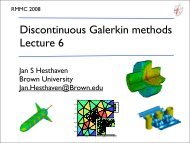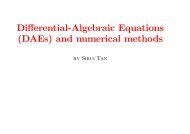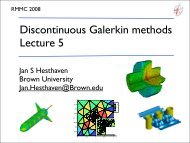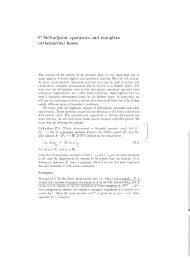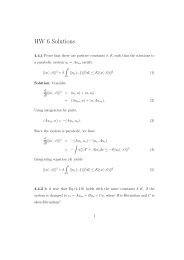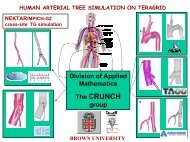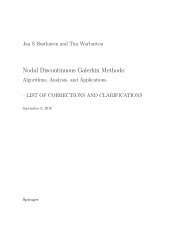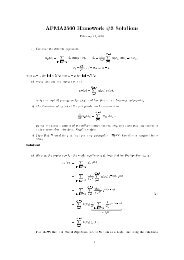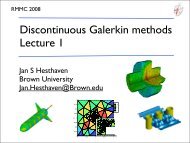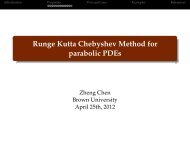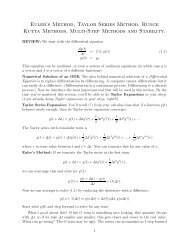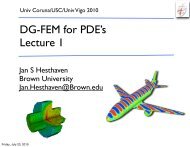MULTI-ELEMENT GENERALIZED POLYNOMIAL CHAOS FOR ...
MULTI-ELEMENT GENERALIZED POLYNOMIAL CHAOS FOR ...
MULTI-ELEMENT GENERALIZED POLYNOMIAL CHAOS FOR ...
You also want an ePaper? Increase the reach of your titles
YUMPU automatically turns print PDFs into web optimized ePapers that Google loves.
926 XIAOLIANG WAN AND GEORGE EM KARNIADAKIS<br />
Fig. 4.1. Cost comparison between ME-gPC and the standard Monte Carlo method for fixed<br />
accuracy. Here p is the order of gPC in each element, N is the number of elements and d is the<br />
number of dimensions. The symbol-lines are iso-cost lines.<br />
Carlo method due to the k-p convergence as shown in cases (i) and (ii) of section 3.2.2.<br />
In Figure 4.1, we present a comparison between the k-convergence O(N −2(p+1) )of<br />
ME-gPC and the convergence O(n −1/2 ) of the standard Monte Carlo method; see [1].<br />
For the same accuracy and different random dimension numbers, the lines show the<br />
cases where the cost of the standard Monte Carlo method is equal to that of ME-gPC.<br />
For a certain random dimension number (denoted by “d”), the region below the line<br />
is where MC is more efficient; the region above the line is where ME-gPC is more<br />
efficient.<br />
In this work we use heuristically the decay rate of relative error of variance as the<br />
indicator for the k-type refinement. A more rigorous a posteriori error estimate is still<br />
needed for the kp-adaptivity. These issues will be addressed in future publications.<br />
Appendix (application of ME-gPC to a stochastic elliptic problem).<br />
Here we briefly elaborate on how to apply ME-gPC to solve differential equations with<br />
stochastic coefficients using the following stochastic linear boundary value problem:<br />
Find a stochastic function, u : D × Ω → R, such that almost surely the following<br />
equation holds:<br />
(4.1)<br />
−∇ · (a(x; ω)∇u(x; ω)) = f(x; ω) on D,<br />
u(x; ω) =0 on∂D,<br />
where D is an open domain in the physical space with Lipschitz boundaries, a(x; ω)<br />
and f(x; ω) are second-order random processes. We assume 0



